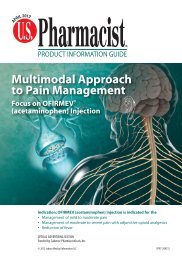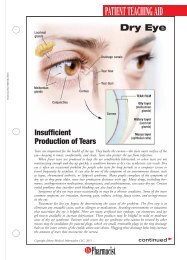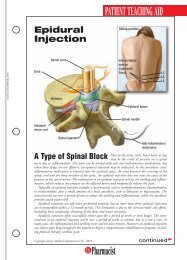View PDF Edition - U.S. Pharmacist
View PDF Edition - U.S. Pharmacist
View PDF Edition - U.S. Pharmacist
Create successful ePaper yourself
Turn your PDF publications into a flip-book with our unique Google optimized e-Paper software.
PATIENT TEACHING AIDBipolarDisorderTEAR ALONG PERFORATIONDramatic High andLow Mood SwingsBipolar disorder, sometimes called manic depression,is a mental illness that is described as a fluctuationin mood extremes. Patients with bipolar disorder mayexperience high (mania) and low (depression) moodswings that are dramatic, seriously affecting their livesand the lives of those around them. The classic picture of bipolar disorder includes swings from high tolow moods and back again, with each swing lasting from weeks to months and often with periods ofnormal mood in between the extremes. During mania, patients are often agitated, speeding throughtheir days with increased activity, little sleep, erratic behavior, and problems concentrating or stayingfocused. During depression, feelings of exhaustion, hopelessness, and futility are common, sometimeswith suicidal thoughts.The cause of bipolar disorder is most likely an imbalance in brain chemicals that affect mood. Thisimbalance may be hereditary, since there is an increased risk of bipolar disorder and schizophreniawithin families. Diagnosis depends on a thorough history of mood and behavior in the past. Althoughabout 1% of the population has been diagnosed with bipolar disorder, the actual number of people isprobably much higher due to misdiagnosis.Without treatment, bipolar disorder is a debilitating condition that will not improve on its own.The goal of treatment is to stabilize the patient’s mood to avoid drastic and damaging mood swings.There are a variety of medications that act to even out the imbalance of brain chemicals thought to bethe cause of bipolar symptoms. Therapy for bipolar disorder often includes individual, group, and familytherapy to help patients and their friends and family understand the triggers, early signs, and treatmentof this condition.Copyright Jobson Medical Information LLC, 2009continued











